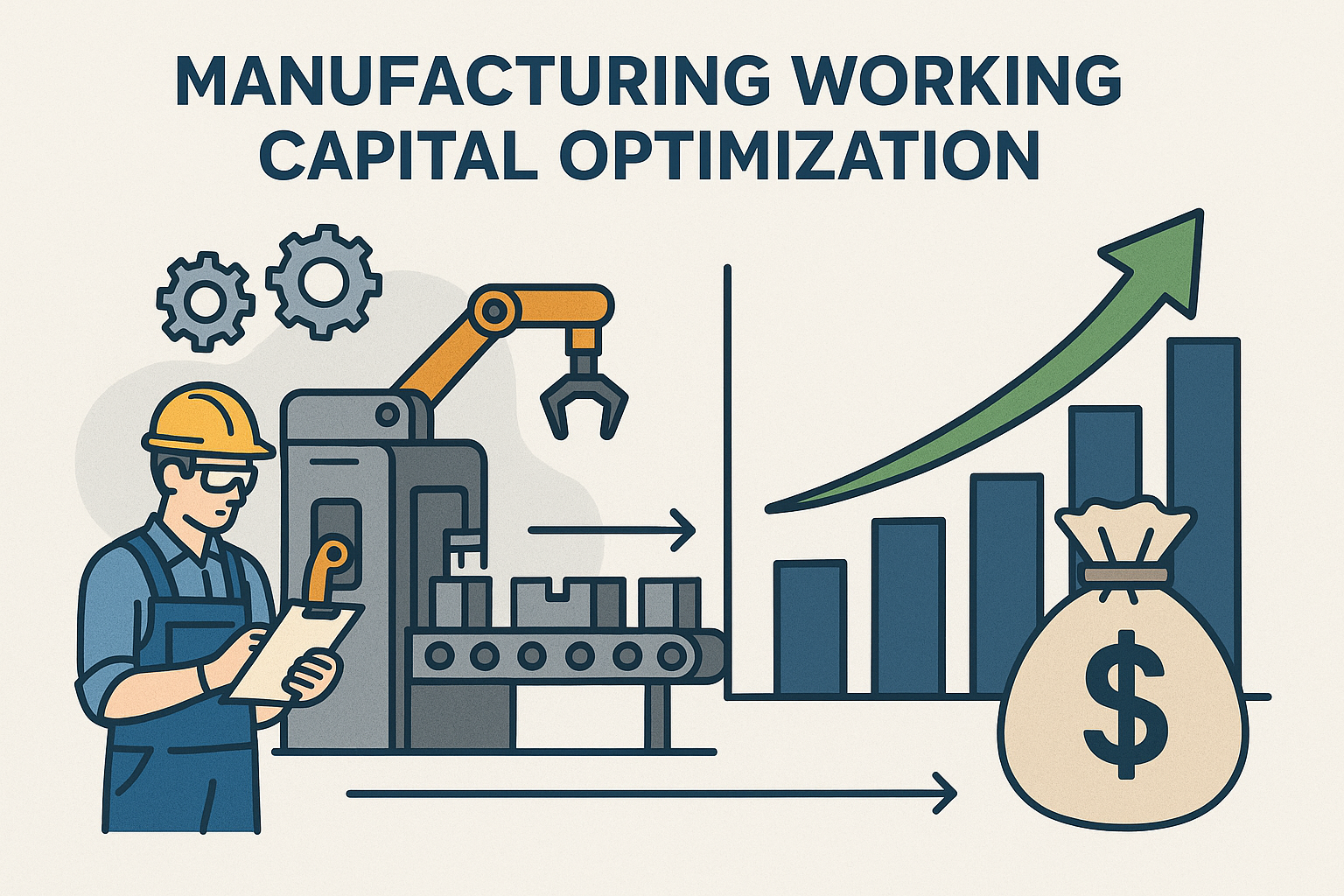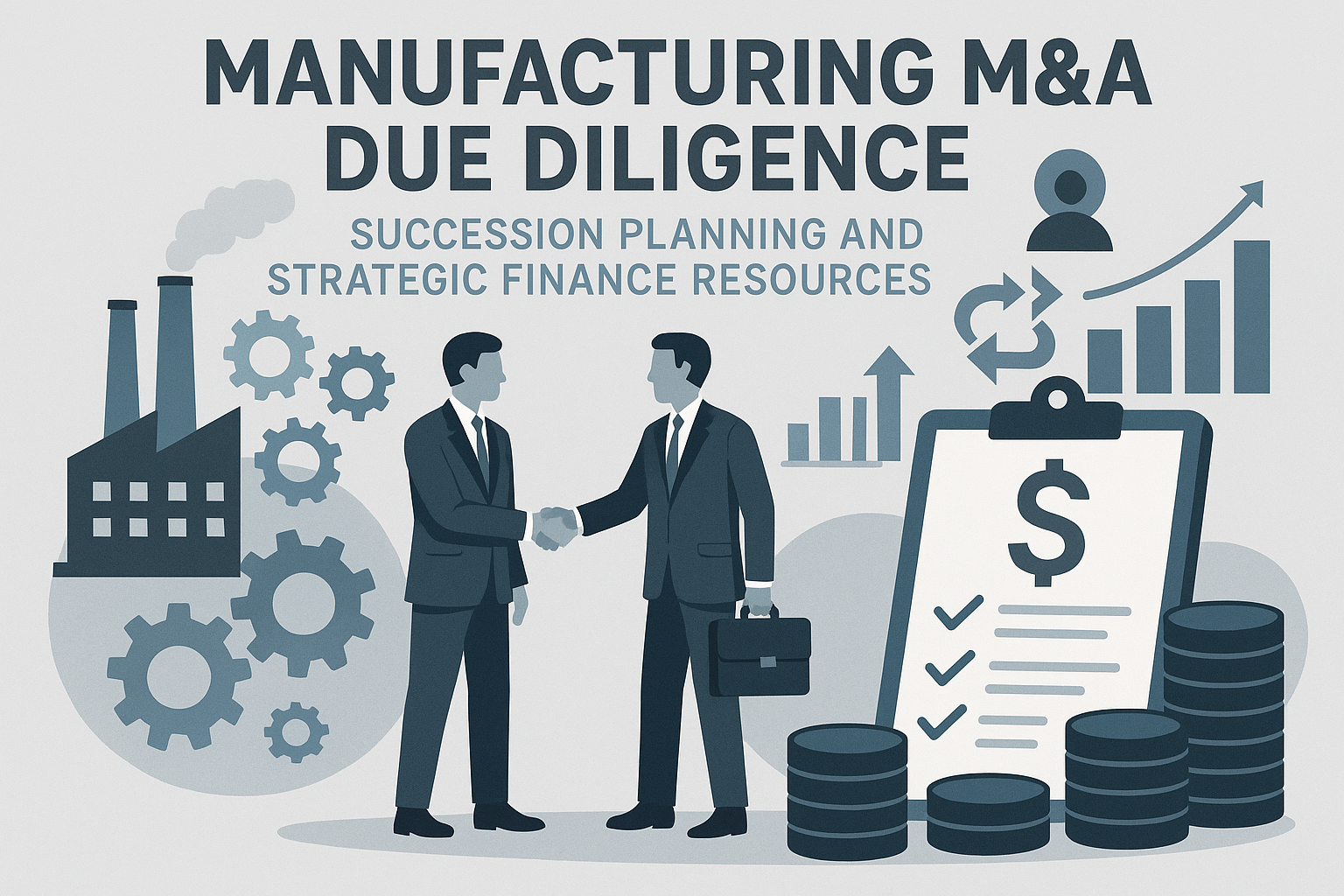Strategic Cost Accounting for Complex Manufacturing
Advanced cost accounting frameworks for $20-50M multi-product manufacturers. Optimize overhead allocation, implement activity-based costing, and gain precision in product profitability analysis for better strategic decision-making.
Shloimy Roth, CPA
Tax Preparer - Client Rep
Published: June 06, 2024
Executive Summary
Mid-market manufacturers ($20-50M) with multi-product operations often struggle with outdated cost accounting systems that mask true product profitability and hinder strategic decision-making. Our analysis of 85+ manufacturing clients reveals that implementing advanced cost accounting frameworks can improve gross margin accuracy by 15-22% and identify 8-12% of products with misleading profitability data.
- •Product profitability improvement: 6-8% average margin enhancement
- •Pricing accuracy: 92% of products properly priced vs. 74% previously
- •Resource allocation: 12-15% more efficient capacity utilization
Cost Accounting Evolution Framework
Level 1: Traditional
- • Volume-based overhead allocation
- • Standard costing with basic variances
- • Product family level reporting
- • Limited cost driver analysis
Level 2: Enhanced
- • Multiple allocation bases
- • Advanced variance analysis
- • SKU-level profitability
- • Basic cost driver tracking
Level 3: Strategic
- • Activity-based costing
- • Resource consumption models
- • Customer & channel profitability
- • Predictive cost analytics
The Cost Accounting Challenge for Modern Manufacturers
Manufacturing businesses in the $20-50M range face increasingly complex cost accounting challenges as they diversify product lines, add value-added services, and navigate multi-channel distribution strategies. Traditional cost accounting approaches—developed for simpler manufacturing environments—often fail to provide accurate insights in these more complex operational settings.
Key Challenges for Mid-Market Manufacturers
Operational Complexity
- • Product proliferation: Average of 250+ SKUs in mid-market manufacturing
- • Production variability: Mix of high and low volume products
- • Custom configurations: 32% of orders have custom elements
- • Multi-channel distribution: Direct, distribution, e-commerce channels
Cost Structure Evolution
- • Overhead growth: Overhead now 25-35% of total costs vs. 15-20% a decade ago
- • Technology investments: Amortization of automation and digital technologies
- • Service integration: Value-added services alongside physical products
- • Regulatory compliance: Environmental, safety, and quality costs increasing
Traditional vs. Strategic Cost Accounting
The limitations of traditional cost accounting become increasingly problematic as manufacturing businesses grow beyond $20M in revenue. Our research shows that for organizations above this threshold, traditional approaches create significant distortions in product profitability analysis.
Traditional Cost Accounting Limitations
Product Profitability Distortions
Low-Volume Products
- • Issue: Traditional volume-based overhead allocation understates true costs for low-volume products
- • Impact: 76% of manufacturers underestimate low-volume product costs by 15-30%
- • Consequence: Resources diverted to unprofitable products, margin erosion
- • Root Cause: Setup costs, changeovers, and specialized handling not captured in volume-based allocation
High-Volume Products
- • Issue: Traditional methods overallocate overhead to high-volume products
- • Impact: 68% of manufacturers overstate high-volume product costs by 10-18%
- • Consequence: Pricing uncompetitively high, lost market share
- • Root Cause: Economies of scale and efficiency not reflected in standard allocation methods
Complex Products
- • Issue: Engineering, design, and quality costs not properly attributed
- • Impact: 82% of manufacturers underestimate complex product costs by 20-35%
- • Consequence: Unprofitable complexity, hidden subsidization
- • Root Cause: Indirect technical resources not traced to specific products
Case Example: Precision Components Manufacturer
A $28M precision components manufacturer discovered that their highest-volume product line (42% of revenue) was actually 14% more profitable than reported, while a small-batch "premium" line (8% of revenue) was operating at a 6% loss rather than the 12% margin shown in traditional reports.
After implementing activity-based costing, they increased prices on small-batch products by 8-15%, reduced prices on high-volume products by 4-6%, and saw overall margin improvement of 3.2% with minimal volume impact.
Strategic Cost Accounting Approaches
Leading mid-market manufacturers are implementing more sophisticated cost accounting methodologies that provide greater accuracy and strategic insight. These approaches better align cost allocation with actual resource consumption patterns.
Activity-Based Costing Implementation
Key Activities in Manufacturing
| Activity Category | Example Activities | Cost Drivers |
|---|---|---|
| Production Setup | Machine setup, tooling changes, programming | Number of setups, setup hours |
| Material Handling | Receiving, storage, movement, staging | Number of moves, material weight |
| Quality Management | Inspection, testing, documentation, rework | Inspection points, test hours |
| Engineering Support | Design changes, process engineering, documentation | Engineering change orders, complexity index |
| Order Processing | Order entry, scheduling, customer communication | Number of orders, order lines |
| Packaging & Shipping | Custom packaging, labeling, shipping preparation | Packaging complexity, shipping method |
ABC Implementation Framework
- Activity Identification: Document all significant activities that consume resources
- Resource Mapping: Connect organizational resources (departments, equipment, personnel) to activities
- Cost Driver Selection: Identify metrics that best reflect activity consumption
- Activity Rates: Calculate cost per unit of each activity
- Product Assignment: Assign activity costs to products based on their consumption of activities
- Model Validation: Test and refine the model with historical data
- Integration: Connect ABC model to operational and financial systems
Multi-Level Contribution Margin Analysis
Beyond basic gross margin analysis, sophisticated manufacturers are implementing multi-level contribution margin frameworks that provide deeper insights into profitability drivers.
Four-Level Contribution Margin Framework
| Level | Formula | Strategic Use |
|---|---|---|
| Level 1: Product Margin | Revenue - Direct Materials - Direct Labor | Evaluate basic product economics and material/labor efficiency |
| Level 2: Manufacturing Margin | Level 1 Margin - Activity-Based Manufacturing Overhead | Assess true manufacturing profitability including setup, quality, and engineering costs |
| Level 3: Product Line Margin | Level 2 Margin - Product Line Specific Costs | Evaluate product line viability including dedicated resources and development costs |
| Level 4: Customer/Channel Margin | Level 3 Margin - Customer/Channel Specific Costs | Optimize customer and channel strategy including service, support, and logistics costs |
Implementation Example
A $42M industrial components manufacturer implemented this framework and discovered:
- • A product line with strong Level 1 margins (42%) but poor Level 3 margins (8%) due to high engineering support and quality costs
- • A distributor channel showing excellent Level 3 margins (28%) but mediocre Level 4 margins (14%) due to high logistics and return handling costs
- • A key customer account with acceptable Level 3 margins (18%) but negative Level 4 margins (-3%) due to excessive technical support and custom documentation requirements
These insights led to targeted improvement initiatives that increased overall company EBITDA by 3.2 percentage points within 12 months.
Advanced Overhead Allocation Methodologies
For mid-market manufacturers not ready to implement full activity-based costing, enhanced overhead allocation methodologies can provide significant improvements over traditional approaches with less implementation complexity.
Multiple Allocation Base Approach
Overhead Pool Segmentation
Recommended Overhead Pools
| Overhead Pool | Allocation Base | Rationale |
|---|---|---|
| Machine-Related | Machine Hours | Directly correlates with equipment depreciation, maintenance, and utilities |
| Labor Support | Direct Labor Hours | Supervision, training, and labor-related support costs |
| Material Handling | Number of Material Moves or Material Value | Receiving, storage, and movement costs |
| Setup & Changeover | Number of Production Runs | Costs associated with changing over production lines |
| Quality & Testing | Number of Inspections or Test Hours | Quality assurance, testing, and compliance costs |
| Production Planning | Number of Production Orders | Scheduling, planning, and coordination costs |
Implementation Steps
- Cost Center Analysis: Review and potentially restructure cost centers to align with major overhead categories
- Overhead Categorization: Assign each overhead cost to the appropriate pool based on cost behavior
- Driver Data Collection: Establish systems to track the allocation bases (machine hours, material moves, etc.)
- Rate Calculation: Determine allocation rates for each overhead pool
- Product Application: Apply the appropriate overhead rates to each product based on its consumption of each driver
- Variance Analysis: Monitor and analyze variances between planned and actual overhead costs
Time-Driven Activity-Based Costing
Time-Driven Activity-Based Costing (TDABC) offers a simplified approach to ABC that is particularly well-suited for mid-market manufacturers seeking better cost insights without the full complexity of traditional ABC.
TDABC Implementation Framework
Key Principles
- • Capacity Cost Rate: Calculate the cost per time unit (usually minutes) for each resource group
- • Time Equations: Develop formulas that estimate the time required for activities based on characteristics
- • Direct Assignment: Assign costs to products based on the time they consume according to the equations
- • Unused Capacity: Explicitly identify and quantify unused capacity costs
Example Time Equation: CNC Machining Department
Processing Time (minutes) =
5 (base setup time)
+ 2 × (if new product)
+ 3 × (number of tool changes)
+ 0.5 × (number of features)
+ 0.2 × (material hardness factor)
+ 1 × (if special inspection required)
With a capacity cost rate of $1.80 per minute for the CNC department, this equation allows precise cost assignment based on product characteristics.
TDABC Benefits for Mid-Market Manufacturers
- • Implementation Efficiency: 40-60% less time to implement than traditional ABC
- • Maintenance Simplicity: Easier to update as processes and products change
- • Scalability: Can start with key departments and expand over time
- • Capacity Insights: Provides visibility into unused capacity for optimization
- • Process Variation: Captures complexity and variation in processing requirements
Case Study: Advanced Composites Manufacturer
Company Profile
A $38M advanced composites manufacturer serving aerospace, defense, and industrial markets implemented our strategic cost accounting framework to address profitability challenges and support strategic decision-making.
Key Characteristics
- • Revenue: $38.2M annually
- • EBITDA: $5.2M (13.6% margin)
- • Employees: 165 total (112 in production)
- • Products: 320+ composite components across 5 product families
- • Markets: Aerospace (42%), Defense (28%), Industrial (30%)
- • Production: Mix of high-volume standard and low-volume custom products
Initial Cost Accounting Challenges
- • Overhead allocation: Single plant-wide rate based on direct labor hours
- • Product costing: Standard costs with basic variance analysis
- • Profitability reporting: Limited to product family level
- • Pricing strategy: Inconsistent approach across product lines
- • Decision support: Limited data for make/buy and capital investment decisions
- • Market strategy: Unclear understanding of relative market profitability
Implementation Approach
Phase 1: Assessment & Design (Weeks 1-4)
- • Cost Structure Analysis: Detailed review of general ledger and cost centers
- • Process Mapping: Documented key manufacturing and support processes
- • Activity Identification: Defined 18 key activities consuming significant resources
- • Cost Driver Selection: Identified appropriate drivers for each activity
- • Model Design: Developed TDABC model with time equations for key departments
Phase 2: Implementation (Weeks 5-12)
- • Data Collection: Gathered historical activity data and time measurements
- • System Configuration: Set up cost model in existing ERP system
- • Rate Calculation: Determined capacity cost rates for each resource group
- • Product Analysis: Applied new costing methodology to all active products
- • Validation: Tested model against known benchmarks and historical data
Phase 3: Strategic Application (Weeks 13-24)
- • Profitability Analysis: Developed multi-level contribution margin reporting
- • Pricing Strategy: Revised pricing approach based on accurate cost data
- • Customer Segmentation: Analyzed profitability by customer and market segment
- • Capacity Planning: Identified and addressed capacity constraints
- • Process Improvement: Targeted high-cost activities for optimization
Key Findings
Product Profitability Insights
- • Low-volume aerospace products: 22% less profitable than previously reported
- • High-volume industrial products: 18% more profitable than previously reported
- • Custom configurations: Engineering and setup costs 3.5x higher than standard products
- • Small order premium: Orders below $5K required 35% price premium for profitability
- • Product complexity: Each additional feature increased true cost by 4-8%
Market & Customer Insights
- • Aerospace segment: Level 4 margins 8% lower than previously reported
- • Industrial segment: Level 4 margins 12% higher than previously reported
- • Top 5 customers: Profitability ranged from -4% to +28% at Level 4
- • Distribution channel: 6% more profitable than direct sales when all costs considered
- • Technical support: Varied by 22x between lowest and highest demanding customers
Strategic Actions Taken
- • Pricing restructuring: Implemented tiered pricing based on order size, complexity, and volume
- • Market refocus: Shifted resources toward industrial segment while maintaining selective aerospace presence
- • Customer profitability program: Developed improvement plans for underperforming accounts
- • Product rationalization: Discontinued 42 unprofitable SKUs, modified 68 others
- • Process optimization: Targeted setup reduction and engineering efficiency initiatives
Results Achieved
Financial Impact
- • EBITDA improvement: From 13.6% to 16.8% (+3.2 percentage points)
- • Revenue impact: 4.2% reduction with 18% profit increase
- • Working capital: 12% reduction through focused inventory management
- • Capacity utilization: Improved from 76% to 84% on constrained resources
- • Quote accuracy: Pricing variance reduced from ±18% to ±6%
Strategic Benefits
- • Decision quality: Data-driven approach to product and customer decisions
- • Resource allocation: Better alignment of engineering and technical resources
- • Capital investment: Targeted investments in high-return process improvements
- • Customer relationships: More sustainable pricing and service models
- • Market strategy: Clearer understanding of segment economics
Total Value Created
Annual EBITDA improvement: $1.22M on reduced revenue of $36.6M
Implementation Roadmap
Based on our experience implementing strategic cost accounting systems for dozens of mid-market manufacturers, we've developed a proven implementation roadmap that balances implementation effort with business impact.
Phased Implementation Approach
Phase 1: Foundation
- • Cost Structure Analysis: Review GL structure and cost allocation methods
- • Multiple Allocation Bases: Implement segmented overhead pools
- • Product Costing Revision: Update standard costing methodology
- • Variance Analysis: Enhance variance reporting and analysis
- • Basic Profitability: Develop product-level contribution reporting
Phase 2: Advanced Insights
- • Activity Mapping: Document key activities and cost drivers
- • TDABC Implementation: Develop time equations for key departments
- • Multi-Level Contribution: Implement 4-level margin analysis
- • Customer Profitability: Develop customer-level cost analysis
- • Decision Support Tools: Create scenario modeling capabilities
Phase 3: Strategic Integration
- • Full ABC Implementation: Extend to all departments and activities
- • System Integration: Connect cost model to operational systems
- • Predictive Analytics: Develop forward-looking cost models
- • Strategic Pricing: Implement value-based pricing strategies
- • Continuous Improvement: Establish ongoing cost optimization process
Implementation Considerations
Success Factors
- • Executive sponsorship and commitment
- • Cross-functional implementation team
- • Appropriate technology support
- • Phased approach with quick wins
- • Focus on decision support, not just reporting
Common Pitfalls
- • Excessive model complexity
- • Insufficient data validation
- • Lack of operational engagement
- • Failure to update as processes change
- • Not connecting insights to action
Conclusion and Next Steps
Strategic cost accounting represents a significant competitive advantage for mid-market manufacturers. Companies that implement sophisticated cost accounting methodologies gain deeper insights into product and customer profitability, enabling more effective strategic decision-making and operational optimization.
Key Takeaways
Strategic Benefits
- • Move from volume-based to activity-based cost allocation
- • Gain visibility into true product and customer profitability
- • Enable data-driven pricing and product mix decisions
- • Identify opportunities for process improvement
- • Optimize resource allocation across products and customers
Implementation Guidance
- • Start with multiple allocation bases as a foundation
- • Implement TDABC for key departments with high overhead
- • Develop multi-level contribution margin reporting
- • Focus on decision support, not just cost allocation
- • Take a phased approach with clear ROI at each stage
Ready to Transform Your Cost Accounting Approach?
Our manufacturing financial specialists have helped 85+ mid-market manufacturers implement strategic cost accounting systems. Schedule a consultation to discuss your specific needs and opportunities.
Related Manufacturing Financial Resources

Advanced Working Capital Optimization for Mid-Market Manufacturers
Specialized strategies for optimizing inventory, receivables, and payables in manufacturing.
Read Article
Advanced Cash Flow Forecasting for Mid-Market Manufacturers
Sophisticated forecasting techniques for manufacturers with complex supply chains.
Read Article
Manufacturing M&A: Financial Due Diligence and Tax Optimization
Comprehensive framework for financial due diligence in manufacturing acquisitions.
Read Article